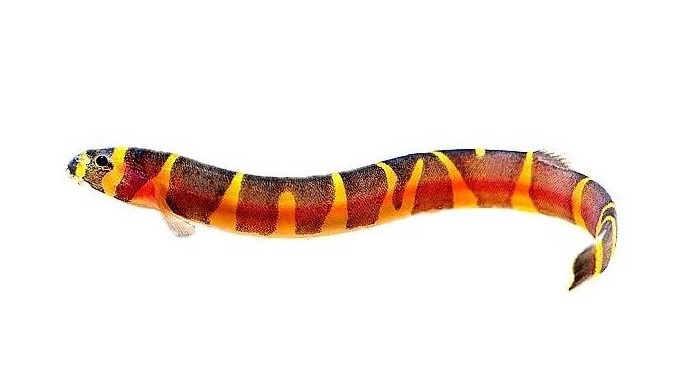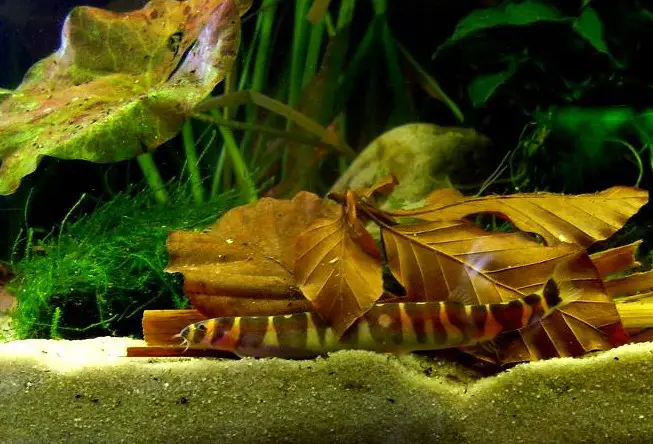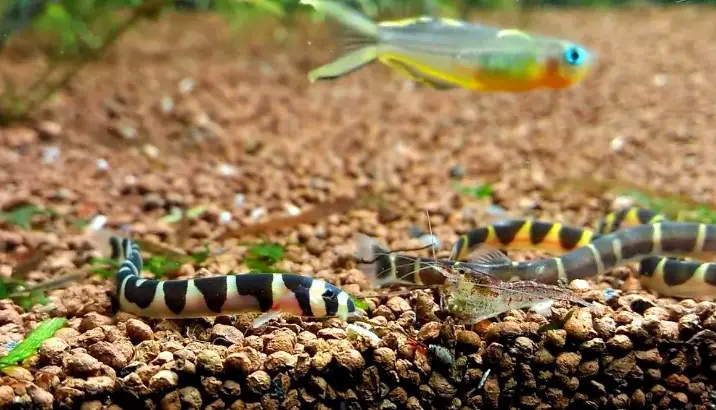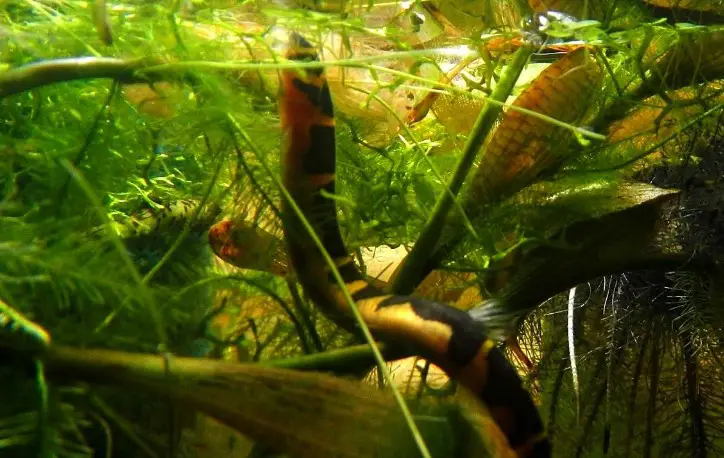Kuhli Loach is a funny, bright, interesting aquarium fish. The non-standard body shape, peculiar behavior, and unpretentious maintenance make Kuhli Loach a very attractive specimen for keeping in a home aquarium!
Appearance
Kuhli Loach has an elongated body, slightly flattened laterally, with very small scales. The fish is very spectacular, with a very unusual color: its body is orange-yellow or reddish, with wide dark transverse stripes. The density and number of stripes vary and can be from 10 to 20 pieces. Near the corners of the mouth, there are three pairs of antennae, 3 – 5 mm each, intended for searching for food. The eyes are covered with a thin protective leathery film, under them there are spines bifurcated at the ends. All fins are small, the dorsal fin is displaced closer to the tail.
Distinguishing a female from a male in Kuhli Loach is quite difficult, and it seems possible only when they reach puberty. Then females become larger and denser than males, as eggs begin to accumulate in females. Through the light walls of the abdomen, many green eggs shine through, from which its color seems greenish-blue. In cross-section, the body of the female resembles the shape of a pear. In males, the second rays of the pectoral fins and pelvic fins are thickened.
Females reach a length of 10 – 12 cm, while males are slightly smaller – about 8 – 10 cm. Life expectancy in a home aquarium is 5 to 10 years.
As a result of selection, the albino form of Kuhli Loach was bred.
Keeping
Kuhli Loach is a crepuscular fish, that is, these fish prefer to spend most of the day in their shelters, and are activated only in the evening and at night. Therefore, the presence in the aquarium of a sufficient number of grottoes of stones and snags is required. Also, thickets of living plants, which they absolutely do not damage, and diffused lighting, which can be achieved with the help of floating plants, are also welcomed. For a Kuhli Loach group of 5 – 7 fish, an aquarium with a volume of 50 liters or more is suitable.
Particular attention should be paid to the soil since Kuhli Loach is able to simply dig into it in search of food. Preference should be given to soft, rounded soil without sharp corners! River sand is best suited for this task.
These fish are very shy and, with the slightest stress, turn pale so that the stripes on the body become barely noticeable. They can also jump out when frightened, so it is advisable that the aquarium be covered with a lid.
Water parameters: 22 – 26 ° С, dGH 5 – 10 ° H, pH 5.5 – 6.5.
Compatibility
Kuhli Loach is a rather small and extremely peaceful aquarium fish. Any non-aggressive species of fish such as Guppies, Tetras, Rasbora, Iris, etc., will become ideal neighbors for him.
Keeping with any burrowing and predatory fish species is unacceptable. That is, all types of Cichlids, as well as even Goldfish, are not suitable for keeping in the same aquarium as Kuhli Loach. Keeping with any large species of crustaceans is also extremely dangerous.
Feeding
Like all bottom-dwelling fish, Kuhli Loach takes food at the bottom of the tank, so it is worth paying attention to whether he is getting enough food. Feeding is best done in the evening when fish are most active. Frozen bloodworms, tubifex, cyclops, and other live food will become his favorite treats. Remember to include sinking dry foods (tablets or pellets) high in plant components in the diet. Delicious and varied food will significantly strengthen the immunity of your fish.
Reproduction and Breeding
Kuhli Loach reaches maturity by the end of the first year of their life. Under natural conditions, spawning occurs during the rainy season in shallow clear water bodies. Fish spawn near the surface, and the spawned and fertilized eggs either stick to the leaves of plants or sink to the bottom.
However, it is almost impossible to achieve reproduction in a home aquarium without hormonal stimulation. Although sometimes under good conditions of keeping and feeding, spawning can occur in the general aquarium, but eggs, as a rule, remain unfertilized and are soon eaten by parents or other fish. Therefore, the successful breeding of Kuhli Loach in a home aquarium is extremely rare.
When the gonadotropic hormone chorionic is used, spawning begins after 6 to 8 hours. An aquarium with a volume of 30 liters (with a water column height of 15 – 20 cm) is suitable for spawning grounds. A net should be placed at the bottom of the aquarium, as the parents eat the eggs. Floating plants (Limnobium, pistia, etc.) are also needed, lighting should be weak and diffused. Water parameters in the range: 26 – 28 ° С, dGH 5 – 15 ° H, pH 6.5 – 7.0.
A female with a noticeably enlarged abdomen (a sign of the presence of eggs) and 2 – 3 males are launched into the spawning grounds. The productivity of one female is 500 – 700 eggs.
The incubation period lasts about a day, after which the larvae appear. On the fourth day, the fry begins to swim and feed. The starter feed will be brine shrimp nauplii, cyclops, or artificial powders and suspensions. After two weeks, they already begin to stain. Fry grows very quickly – by the end of the first month, their length reaches 1.5 – 2 cm.

